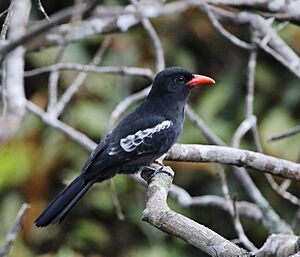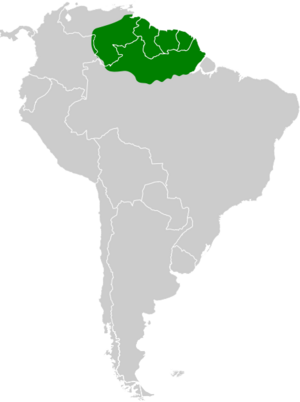Black nunbird facts for kids
Quick facts for kids Black nunbird |
|
|---|---|
 |
|
| Black nunbird at Manaus, Amazonas state, Brazil | |
| Conservation status | |
| Scientific classification | |
| Genus: |
Monasa
|
| Species: |
atra
|
 |
|
The black nunbird (Monasa atra) is a type of bird that belongs to the puffbird family. These birds are known for their somewhat fluffy look. You can find black nunbirds in South America. They live in countries like Brazil, French Guiana, Guyana, Suriname, and Venezuela.
Contents
About the Black Nunbird
The black nunbird is a fascinating bird. It is part of a group of birds called near-passerines. This means they are not true songbirds, but they are related to them.
What's in a Name?
The scientific name for the black nunbird is Monasa atra.
- The word Monasa comes from an Ancient Greek word. It means "solitary" or "alone."
- The word atra comes from Latin. It means "black."
So, its name basically means "solitary black bird"!
Scientists sometimes group the black nunbird with other nunbirds. These include the black-fronted nunbird and the white-fronted nunbird. They are all quite similar.
What Does It Look Like?
The black nunbird is about 25 to 29 centimeters (10 to 11 inches) long. It weighs between 74 and 104 grams (2.6 to 3.7 ounces).
- Its upper body is a shiny blue-black color.
- Its belly and chest are dark to light gray.
- It has a wide white band on its wings. You can see this when its wings are folded.
- Its bill (beak) is bright red.
- Its eyes can be red or brown.
- Its legs and feet are a dark gray color.
Young black nunbirds look a bit different. They are usually darker on top and browner underneath.
Where Do They Live?
Black nunbirds live in parts of South America.
- They are found in southern and eastern Venezuela.
- They also live across the Guianas (French Guiana, Guyana, Suriname).
- In Brazil, they live north of the Amazon River.
- They might also live in eastern Colombia, but this is not fully confirmed.
These birds prefer humid forests. They like areas at the edge of forests, near water, or in slightly open spaces. You can spot them at any level of the forest. They might be in the low bushes or high up in the treetops. They live from sea level up to about 1,000 meters (3,300 feet) high.
Black Nunbird Behavior
Black nunbirds have interesting ways of finding food and raising their young.
How Do They Find Food?
Black nunbirds are skilled hunters.
- They usually sit on a branch and wait.
- When they see prey, they quickly fly out to catch it.
- They often grab insects or spiders from leaves and branches.
- Sometimes, they catch insects right in the air.
- Their diet includes insects, spiders, and other small creatures.
- They also eat small lizards.
- Black nunbirds are known to follow army ant swarms. These ants stir up insects, making them easy to catch.
Raising a Family
Black nunbirds build their nests in holes. These holes are usually in flat ground.
- In Venezuela, they breed between March and May.
- In French Guiana, they breed from August to September.
- Near Manaus, Brazil, they seem to nest twice a year.
What Do They Sound Like?
The black nunbird has unique calls and songs.
- Their songs sound like a flute. They make sounds like "whoo-doo-doo" or a descending "hyoo-hoo-hoo-oo-oo-oo".
- Their calls can be loud. They sound like "yawkl-diddl" or "quee-didada".
Black Nunbird Status
The IUCN (International Union for Conservation of Nature) keeps track of how many animals are in the wild. They have listed the black nunbird as a species of "Least Concern."
- This means they are not currently in danger of disappearing.
- They live across a very large area.
- Even though we don't know the exact number of black nunbirds, their population seems stable.
- They are considered common in most places where they live.


